Researchers Quantify The Navajo Nation’s Water Crisis
5:23 minutes
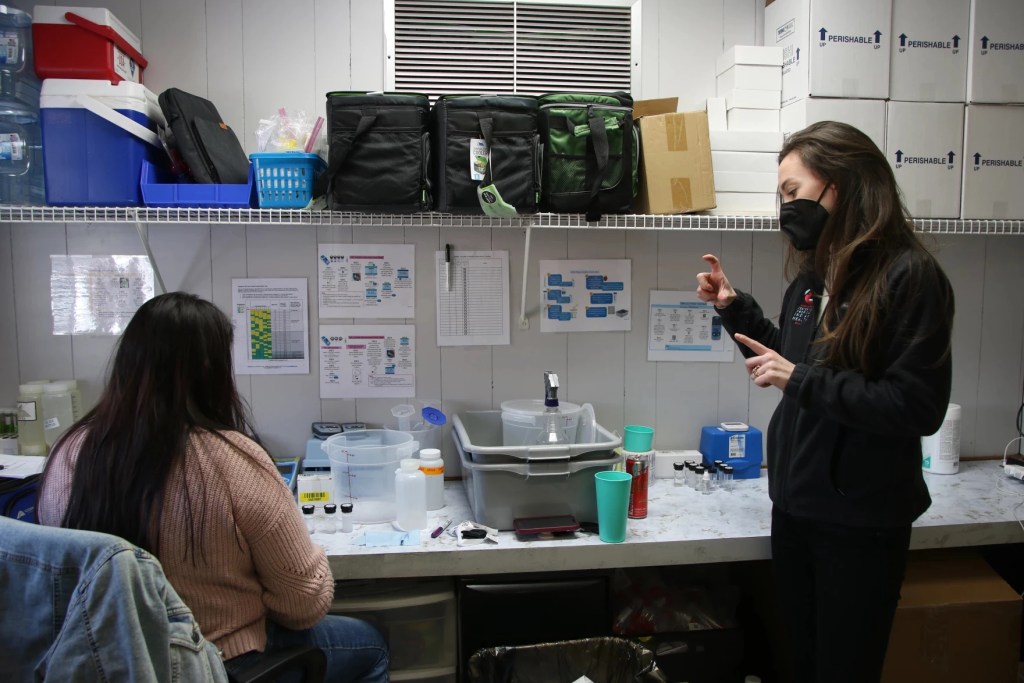
This article is part of The State of Science, a series featuring science stories from public radio stations across the United States. This story, by Emma VandenEinde, was originally published by KUNC.
In Fort Defiance, one of five main communities situated on the Arizona-New Mexico border in the Navajo Nation, Taishiana Tsosie and Kimberly Belone are standing in a mobile office’s cramped bathroom.
The two researchers from the Johns Hopkins Center for Indigenous Health turn off the lights and hold up plastic bags filled with water from the bathroom sink. Each bag has five small compartments, filled with the same sink water. Where they differ is in the chemicals added to each compartment.
“This is our compartment bag, and we use this and several other chemicals and tablets to test for E. coli in the water,” Tsosie said.
Today, the researchers are testing for harmful bacteria, but they also run separate tests for dangerous metals in drinking water.
Belone shines a black light on one of the bags from the mobile office sink. Some of the compartments on the bag glow slightly, signifying potential bacterial water contaminants.
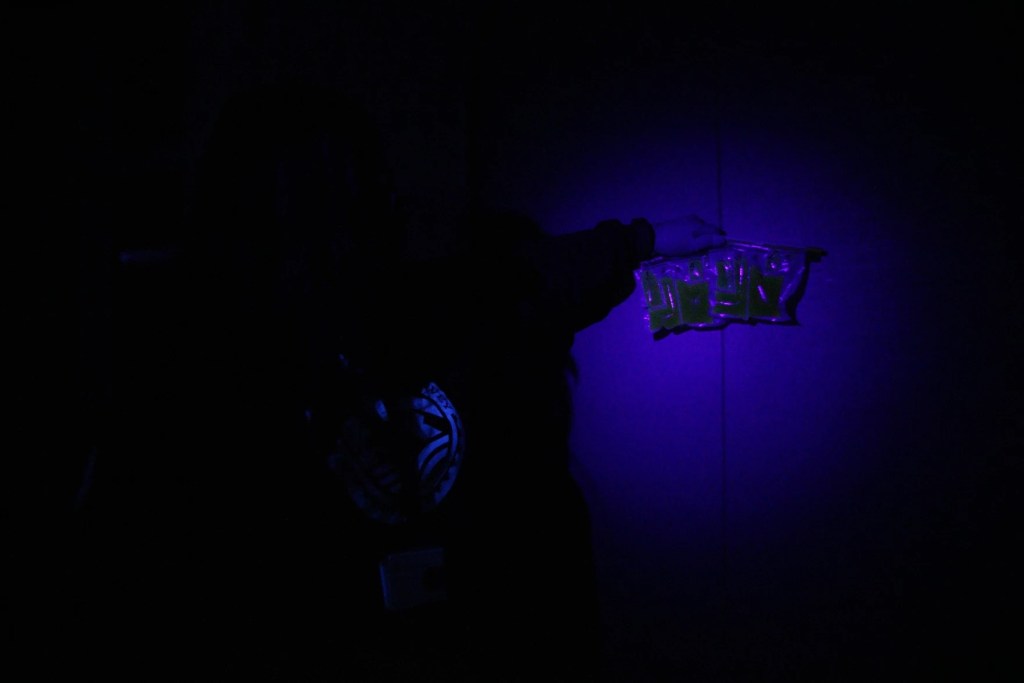
“What we’re looking for is…basically if it’s glowing really, really bad,” Tsosie said. “(We’re) looking for very distinct fluorescent abnormalities in the water.”
Belone and Tsosie compare results against an E. coli-positive control bag from a stream down the road. They don’t think there’s any E. coli in the bags of water from the mobile office, but harmless bacteria are visible in some of the glowing compartments, according to Belone.
“I think (compartments) two and three on both of them are fluorescent,” Belone said.
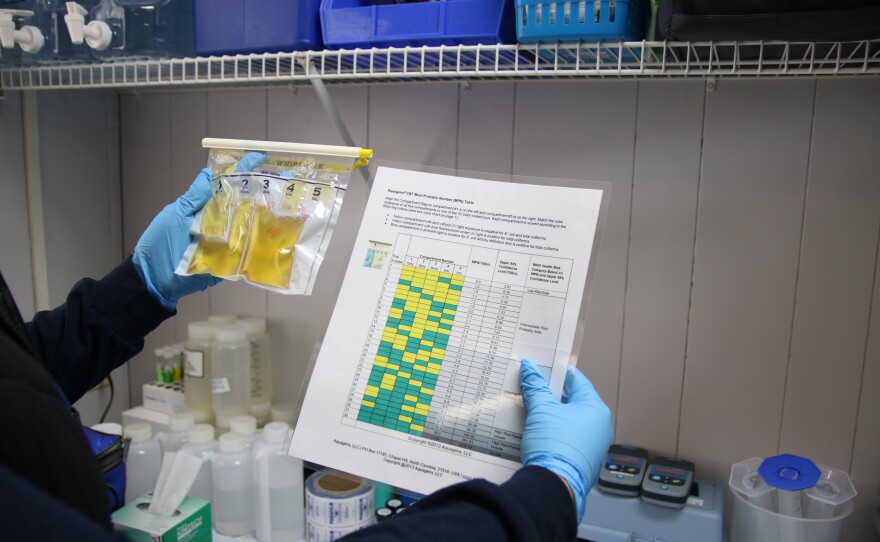
This test is part of the Diné Household Water Survey, a first-of-its-kind two-year project led by Johns Hopkins University. Launched in late 2021, the project aims to accurately quantify the number of households without access to safe drinking water in Fort Defiance.
Across the entire Navajo Nation – the largest reservation in the U.S., which stretches across parts of Arizona, New Mexico, and Utah – roughly 30% of its residents lack access to clean, reliable drinking water, according to the Navajo Nation Department of Water Resources.
“This is a really ambitious project for a pilot, but it is a really urgent need and it has to be done, like, yesterday,” said Reese Cuddy, a Santa Fe-based Johns Hopkins researcher who’s directing the project. “You may not think (these challenges) are right here in the U.S. but they are and they (the residents) need help. And we need to be able to show what it is they’re dealing with and then find solutions so they’re no longer dealing with this on their own.”
Tsosie and Belone are both personally familiar with the Navajo Nation’s water woes. They tell of their families growing up on the reservation without running water. Tsosie recollected that when her family finally got running water at home, it was yellow. Both their parents and grandparents were forced to haul water from wells and other public water holes.
“That’s the thing – it is a basic thing,” Belone said. “Everyone should be entitled to running water and all of that—but we’re not, here.”
The household water study is designed to illuminate the water issues that have been exacerbated by poverty, substandard housing, water scarcity and, ultimately, federal negligence.
“Centuries of oppression and broken promises have created an inexcusable situation,” Cuddy said. “I can say that about water, but I can say that about a lot of other things.”
The pandemic put a spotlight on the stark water inequities in the Navajo Nation. With so many people lacking the running water necessary to practice basic hygiene, COVID-19 quickly ravaged the Navajo Nation. Among the other compounding risk factors is that many Navajo homes are multigenerational, which meant additional pandemic risk factors.
“COVID numbers on Navajo really jumped up and a lot was pointing to—well, water access is a big contributor to this,” Cuddy said.
As case counts climbed in 2020, the Indian Health Service (IHS) and the Johns Hopkins Center for Indigenous Health, among other groups and agencies, partnered with the tribe and formed the Navajo Nation COVID-19 Water Access Coordination Group to expand water access. That collaboration led to the creation of the Diné Household Water Survey in Fort Defiance. It’s a pilot project now, but researchers plan to expand it to cover the rest of the Navajo Nation once the pilot finishes in November.
Unlike prior water surveys on the reservation, this one uses satellite imagery to map all homes in the Fort Defiance area, including some Navajo homes that are often not counted in other surveys.
“Some people live in a hogan, some people live in a trailer, some people live in a home, some people live in sheds that aren’t insulated,” Cuddy said. “Some of those different housing units don’t have a floor—they’re dirt floors—and IHS doesn’t actually count those homes as livable units so they’re left out of the data set.”
In this survey, homes are randomly selected for a visit by researchers. Then, Tsosie, Belone and other researchers head out on winding dirt roads to find them – which can be difficult since there’s little cell phone reception and homes here often lack addresses.
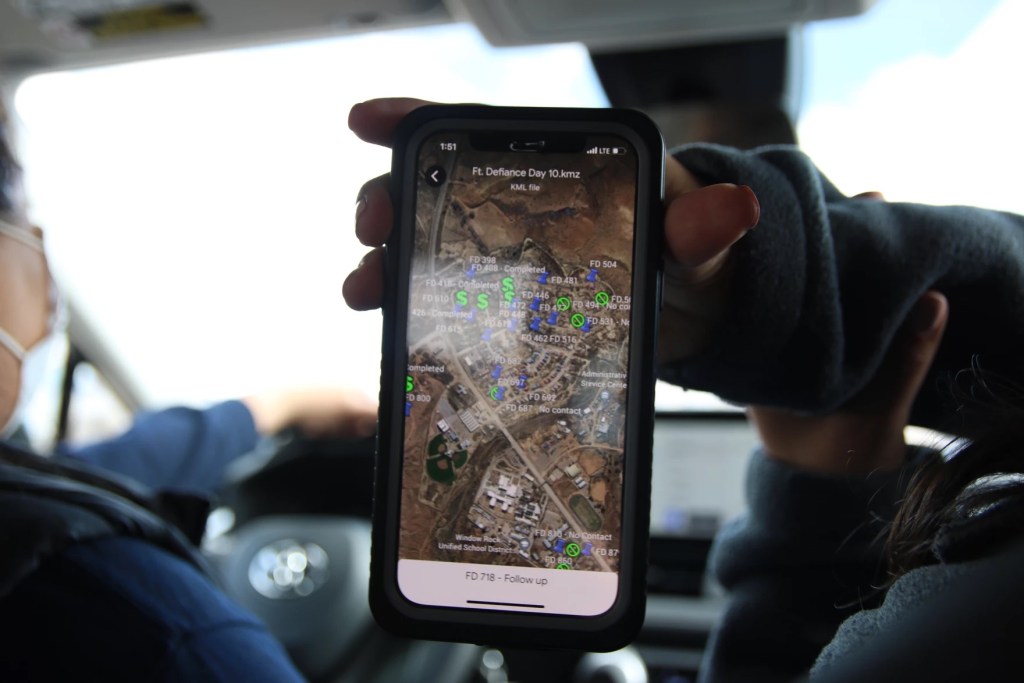
On an outing in early February, Tsosie and Belone are counting roads they pass as they look for a hogan, a traditional Navajo hut.
“So this would be seven, eight, right?” Tsosie asked.
“No, this isn’t it…No, it is!” Belone replied.
At each home, they ask residents if they’re willing to be interviewed anonymously about their water: where it comes from, its quality and their preferences for water solutions. In return, participants receive a gift card.
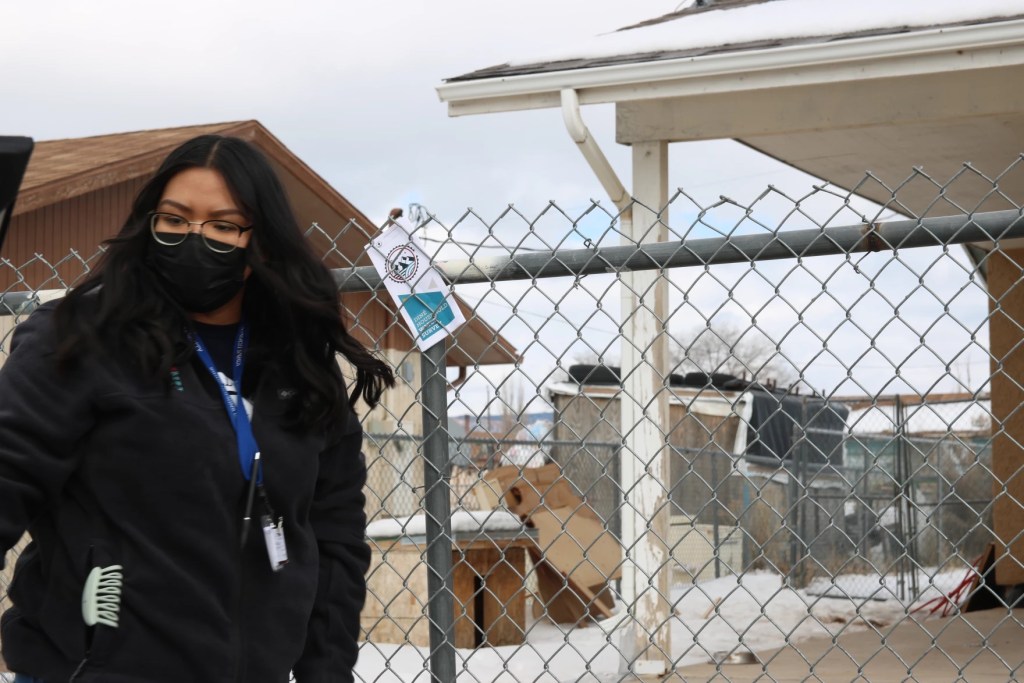
They’ll survey more than 1,150 homes over the two years of the project and 100 of those homes will be selected for water testing like the black light test Tsosie and Belone conducted.
The interviews with residents can be “a rollercoaster of emotions,” according to Belone. She recalled a survey interview with an old man who was struggling to haul water.
“(He) had said something along the lines of, ‘In a few years, I can’t do this. I can’t continue to do this. I’m not getting any younger,’” Belone said. “He was like, ‘I’m not going to have anybody to do this, so that might be the end of us if I can’t haul water anymore.’”
There are no easy solutions. Heather Himmelberger, the director of the Southwest Environmental Finance Center at the University of New Mexico, said maintaining existing infrastructure is a huge challenge, much less upgrading and expanding it.
“We’re not talking about large populations,” Himmelberger said of the tribal communities she’s worked with in New Mexico. “You have these very expensive infrastructure projects with very few people who can pay for them, so you can imagine that that becomes problematic over time.”
Cuddy said the same is true across the Navajo Nation.
“It takes, in some cases, millions of dollars to get a pipe out to a really remote home, and they’re most likely always going to fall off the funding list due to that high expense and the geographic constraints,” she said. “In addition, they have really hard rock in a lot of these communities across Navajo and it’s very difficult to make the infrastructure and get through that rock.”
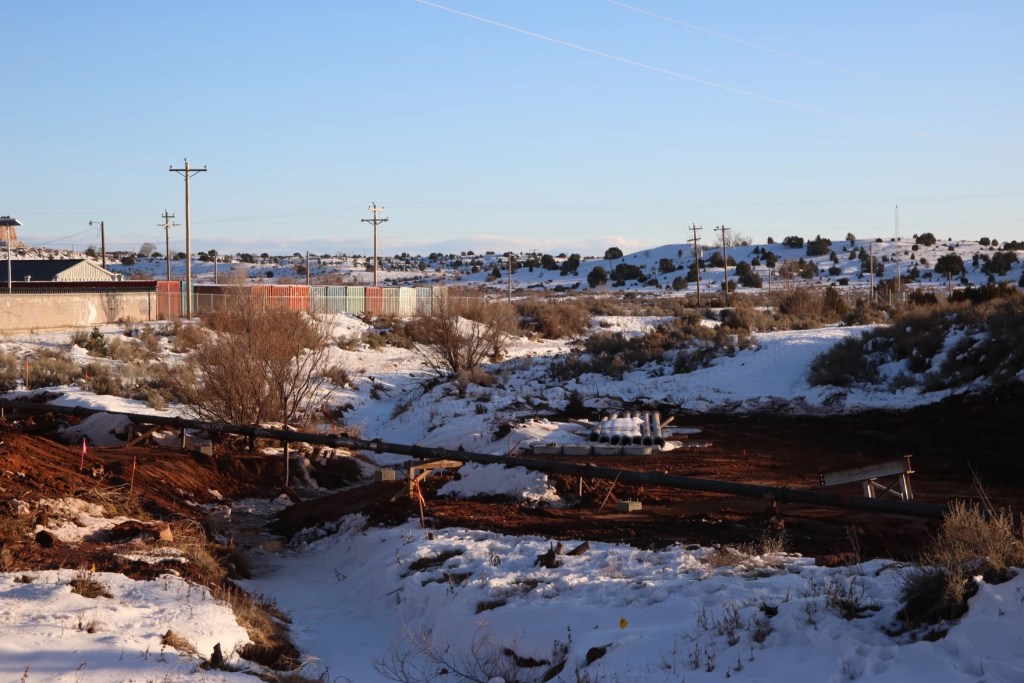
Last year, the Southwest Environmental Finance Center published a study on tribal water systems and infrastructure funding in the Rio Grande pueblos. It found that many tribal communities are unaware of available funding and are also ill-equipped to apply for it. What’s more, the funds that are awarded are often insufficient.
“Now how do you restructure the project if you don’t get all the money?” Himmelberger said. “What are you going to do? What part gets done? What part doesn’t get done? And then how does that affect that community for a longer time frame?”
Belone said these infrastructure challenges are familiar on the Navajo Nation and across Indian Country, but many people in the United States are oblivious to such issues and can’t relate.
“You have to see it firsthand,” she said. “You have to see how our homes and our neighborhoods look. You have to drive through our roads and hit all of the potholes and try to miss the dogs that are running across the road…You have to be hopeful that someone sees the benefit of (the project) without having to come out here.”
But Belone is buoyed by the people the survey is intended to help.
“Many of them are really, really grateful,” Belone said. “They’re like, ‘Thank you. Nobody has asked me these questions. Thank you for being the one to actually start something.’”
This story was produced by the Mountain West News Bureau, a collaboration between Wyoming Public Media, Nevada Public Radio, Boise State Public Radio in Idaho, KUNR in Nevada, the O’Connor Center for the Rocky Mountain West in Montana, KUNC in Colorado, KUNM in New Mexico, with support from affiliate stations across the region. Funding for the Mountain West News Bureau is provided in part by the Corporation for Public Broadcasting.
This story was also supported by The Water Desk, an initiative from the University of Colorado Boulder’s Center for Environmental Journalism.
Emma VandenEinde is a Mountain West Reporter at KUNC in Littleton, Colorado.
JOHN DANKOSKY: This is Science Friday. I’m John Dankosky.
DIANA PLASKER: And I’m Diana Lasker. Now it’s time to check in on the state of science.
SPEAKER 1: This is KE–
SPEAKER 2: For WWNO.
SPEAKER 3: Saint Louis Public Radio.
SPEAKER 4: Iowa Public Radio News.
DIANA PLASKER: Local science stories of national significance. We talk a lot on this show about how the Western US is dealing with drought. Water scarcity is becoming a larger issue for many communities. This is especially true in Navajo Nation, the largest reservation in the country. It’s estimated that nearly a third of residents don’t have access to consistently clean drinking water. Joining me to talk about work that’s being done to make drinking water safer is my guest Emma Vandeneinde, Mountain West reporter for KUNC in Greeley, Colorado. Welcome to Science Friday.
EMMA VANDENEINDE: Yeah, thank you, Diana. I’m happy to be here.
DIANA PLASKER: So tell us why is clean water so sparse in Navajo Nation?
EMMA VANDENEINDE: So the Navajo Nation doesn’t have clean water because there’s a lack of infrastructure there. I mean, you said it yourself. Roughly, a third of the nation’s population doesn’t have reliable access to clean drinking water. And that’s according to the Navajo Nation’s Department of Water Resources. And honestly, those numbers don’t always tell the whole story, since that’s just drinking water. I mean, that’s not even piped water or plumbing.
But saying a lack of infrastructure isn’t entirely true either, as this lack of infrastructure has been caused by a legacy of neglect by the federal government. The Navajo people were forced onto these resource-poor reservations and were not given the rights to do much with the land.
DIANA PLASKER: So there are health problems associated with bad water quality. But you’ve reported on one that may not be top of mind– reliance on soda and sugary drinks. Explain to us how big of an issue this is at Navajo Nation.
EMMA VANDENEINDE: So as I mentioned, clean water isn’t easily accessible on the Navajo Nation. We’re talking like driving one to two hours to get to a public watering hole or a department store to get water. But there are restaurants or gas stations that are closer and have soda for sale. They’re often cheaper than a bottle of water. And when you have a young child that’s crying for something, it can be an easy choice for families.
But it’s become a major issue on the Navajo Nation. The New Mexico Department of Health found that childhood obesity for American Indian third graders increased to more than 42% in 2021. The Notah Begay III Foundation, a native children’s health group, found that more than 85% of Navajo kids have at least one sugary beverage a day. And because of this, some researchers are finding data that these children might not outlive their parents.
DIANA PLASKER: Wow. So you just mentioned the researchers. What kind of work is being done to replace soda with more reliable water access in tribal communities?
EMMA VANDENEINDE: There’s actually several groups working on solutions. The Johns Hopkins Center for Indigenous Health in Fort Defiance, they launched a study to see if delivering water to mothers homes and teaching the mothers some health tips for raising their child would make a difference. And it did. The kids that were part of the experimental group had a lower body mass index and drank less sugar sweetened beverages.
The other group I spoke with for my story was Notah Begay III Foundation. It received a $100,000 to help eight native organizations encourage water consumption in their communities. And they got creative. Some of them did a school water challenge to see how many kids would drink fruit-infused water. And there was another group that put up signs that designated no sugar zones at a wellness center in their community. It’s clear that this is a concern.
DIANA PLASKER: It’s amazing. It’s kind of like the gamification of drinking water. That’s great. You reported on a study that’s going home to home in Navajo Nation to try and get detailed data on the state of water quality in communities. What challenges have the researchers found?
EMMA VANDENEINDE: Well, it really all comes back to infrastructure. What Johns Hopkins is finding in this study is not surprising that many people don’t have access to running water in their home. But when it comes to solutions, they’re not as simple as one might think. Here’s Reese Cuddy, a research associate at the Johns Hopkins Center for Indigenous Health.
REECE CUDDY: It takes, in some cases, millions of dollars to get a pipe out to a really remote home. And they’re most likely always going to fall off the funding list due to that high expense and the geographic constraints.
EMMA VANDENEINDE: Cuddy added that the geography is not in their favor, as the Navajo Nation is on top of really hard rock, which makes it difficult to dig underground. And while there’s a lot of grants out there, most of these people don’t have access to a computer to even send forward an application. And even if they do receive these grants, usually the funds aren’t sufficient to build something that substantial.
DIANA PLASKER: Wow. So what’s next for this project? What can we look forward to in the future?
EMMA VANDENEINDE: So right now, the Johns Hopkins researchers are in the process of surveying more than 1,150 homes over the next two years of the project just in the Fort Defiance area. And 100 of those homes will be selected for water testing. Basically, what they do is take a sample of the water that these families do have. And they will add chemicals to it and look under blacklight to see if there’s E. coli or other contaminants in the water. Ideally, with some more funding, they plan to expand the project to the rest of the Navajo Nation once the pilot finishes in November.
DIANA PLASKER: Amazing. Thank you for this reporting, Emma. And that’s all the time we have. So I’d like to thank you for being here.
EMMA VANDENEINDE: Thank you, Diana.
DIANA PLASKER: Emma Vandeneinde, Mountain West reporter for KUNC in Greeley, Colorado.
Copyright © 2023 Science Friday Initiative. All rights reserved. Science Friday transcripts are produced on a tight deadline by 3Play Media. Fidelity to the original aired/published audio or video file might vary, and text might be updated or amended in the future. For the authoritative record of Science Friday’s programming, please visit the original aired/published recording. For terms of use and more information, visit our policies pages at http://www.sciencefriday.com/about/policies/
Kathleen Davis is a producer and fill-in host at Science Friday, which means she spends her weeks researching, writing, editing, and sometimes talking into a microphone. She’s always eager to talk about freshwater lakes and Coney Island diners.
Diana Plasker was the Senior Manager of Experiences at Science Friday, where she created live events, programs and partnerships to delight and engage audiences in the world of science.